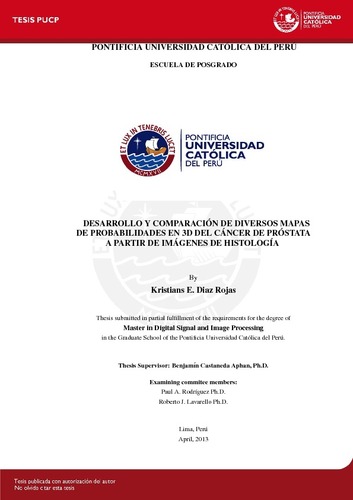| dc.contributor.advisor | Castañeda Aphan, Benjamín | |
| dc.contributor.author | Díaz Rojas, Kristians Edgardo | es_ES |
| dc.date.accessioned | 2013-12-04T21:31:05Z | es_ES |
| dc.date.available | 2013-12-04T21:31:05Z | es_ES |
| dc.date.created | 2013 | es_ES |
| dc.date.issued | 2013-12-04 | es_ES |
| dc.identifier.uri | http://hdl.handle.net/20.500.12404/5008 | |
| dc.description.abstract | Understanding the spatial distribution of prostate cancer and how it changes according
to prostate specific antigen (PSA) values, Gleason score, and other clinical parameters may
help comprehend the disease and increase the overall success rate of biopsies. This work
aims to build 3D spatial distributions of prostate cancer and examine the extent and location
of cancer as a function of independent clinical parameters. The border of the gland and
cancerous regions from whole-mount histopathological images are used to reconstruct 3D
models showing the localization of tumor. This process utilizes color segmentation and
interpolation based on mathematical morphological distance. 58 glands are deformed into
one prostate atlas using a combination of rigid, a ne, and b-spline deformable registration
techniques. Spatial distribution is developed by counting the number of occurrences in
a given position in 3D space from each registered prostate cancer. Finally a di erence
between proportions is used to compare di erent spatial distributions. Results show that
prostate cancer has a significant di erence (SD) in the right zone of the prostate between
populations with PSA greater and less than 5 ng=ml. Age does not have any impact in the
spatial distribution of the disease. Positive and negative capsule-penetrated cases show a SD
in the right posterior zone. There is SD in almost all the glands between cases with tumors
larger and smaller than 10% of the whole prostate. A larger database is needed to improve
the statistical validity of the test. Finally, information from whole-mount histopathological
images could provide better insight into prostate cancer. | es_ES |
| dc.description.uri | Tesis | es_ES |
| dc.language.iso | spa | es_ES |
| dc.publisher | Pontificia Universidad Católica del Perú | es_ES |
| dc.rights | Atribución-NoComercial-CompartirIgual 2.5 Perú | * |
| dc.rights | info:eu-repo/semantics/openAccess | es_ES |
| dc.rights.uri | http://creativecommons.org/licenses/by-nc-sa/2.5/pe/ | * |
| dc.subject | Procesamiento de señales e imágenes digitales | es_ES |
| dc.subject | Reconocimiento de imágenes | es_ES |
| dc.subject | Cáncer | es_ES |
| dc.title | Desarrollo y comparación de diversos mapas de probabilidades en 3D del cáncer de próstata a partir de imágenes de histología | es_ES |
| dc.type | info:eu-repo/semantics/masterThesis | es_ES |
| thesis.degree.name | Magíster en Procesamiento de señales e imágenes digitales | es_ES |
| thesis.degree.level | Maestría | es_ES |
| thesis.degree.grantor | Pontificia Universidad Católica del Perú. Escuela de Posgrado | es_ES |
| thesis.degree.discipline | Procesamiento de señales e imágenes digitales | es_ES |
| renati.advisor.dni | 10791304 | |
| renati.discipline | 613077 | es_ES |
| renati.level | https://purl.org/pe-repo/renati/level#maestro | es_ES |
| renati.type | http://purl.org/pe-repo/renati/type#tesis | es_ES |
| dc.publisher.country | PE | es_ES |
| dc.subject.ocde | https://purl.org/pe-repo/ocde/ford#2.02.05 | es_ES |






